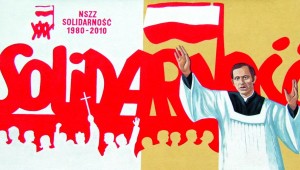Nonviolent Social Movements: The Street Spirit Interview with Stephen Zunes

Polish mural commemorating 30 years of the Solidarity Movement; Father Jerzy Popieluszko foreground; artist unknown.
“In Bolivia in 1979, when there was a coup by a general named Natusch Busch, the whole country went on strike and 600,000 people massed in the Bolivian capital of La Paz, which was bigger than the total population of the city at the time. Trade union leaders and others walked into the president’s house, walked into his office, and they asked him, “What’s your program?” He looked at them, and then he looked at the 600,000 people out in the streets, and he said, ‘Yours!’” Stephen Zunes
Street Spirit: In your book, Nonviolent Social Movements: A Geographical Perspective, you and your co-authors described how nonviolent movements all over the world have undermined powerful systems of oppression through the mass withdrawal of cooperation. How can such a seemingly passive act as non-cooperation overcome a military dictatorship?
Stephen Zunes: Well, basically, for the state to operate, it needs people to carry out its orders — ranging from the security forces, to government bureaucrats, to sympathetic people in the media, to academics, and to many other people that may, in normal times, do the duty of the state, but can be convinced to be on the side of the people.
This is striking. I was in Bolivia a few years ago where they have had a long history of nonviolent resistance against right-wing dictatorships and neo-liberalism and all sorts of injustices. And it was amazing when I talked to everyone from illiterate peasants, to intellectuals, to people in the government, to urban workers — they’ll all tell you that the most powerful person in Bolivia is not the president or any elected officials, but the head of the trade union federation. Why? Because the unions can shut down the entire country.
So if there’s a general strike or other forms of mass resistance, it doesn’t matter if the government occupies various government offices, and has a monopoly of weapons, or, in some cases, a monopoly of media. If people refuse to obey their orders, then they don’t have any power.











